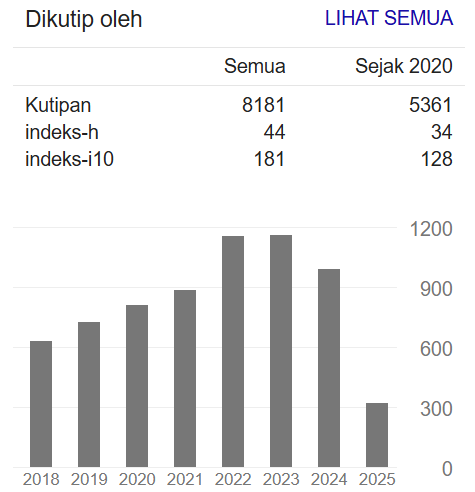SYNERGISTIC EFFECTS OF NANOCURCUMIN AND CISPLATIN COMBINATION THERAPY ON APOPTOSIS AND PROTEIN KINASE B (AKT) IN CERVICAL CANCER
DOI:
https://doi.org/10.34011/jmp2k.v35i3.3169Keywords:
apoptosis, cisplatin, kanker serviks, nanokurkumin, protein kinase B (AKT)Abstract
Kanker serviks merupakan salah satu jenis kanker yang sering dijumpai pada wanita dan penyebab utama kematian di negara berkembang, termasuk Indonesia. Kemoterapi berbasis cisplatin merupakan terapi standar, namun penggunaannya dibatasi oleh toksisitas yang bergantung pada dosis, seperti nefrotoksisitas, neurotoksisitas, dan kardiotoksisitas. Penelitian ini bertujuan untuk mengevaluasi efek sinergis kombinasi nanokurkumin dan cisplatin terhadap tingkat apoptosis dan ekspresi Protein Kinase B (AKT) pada sel HeLa. Metode yang digunakan adalah eksperimen dengan desain post-test only control group, dengan kelompok kontrol negative (media standar), kontrol positif monoterapi cisplatin (5 dan 2,5 µg/mL), nanokurkumin (100 µg/mL), serta kombinasi cisplatin 2,5 µg/mL dan nanokurkumin berbagai dosis (25, 50, dan 100 µg/mL). Uji flow cytometry digunakan untuk menganalisis tingkat apoptosis dan ekspresi AKT setelah 48 jam inkubasi. Hasil penelitian menunjukkan bahwa kombinasi cisplatin 2,5 µg/mL dan nanokurkumin 100 µg/mL menyebabkan apoptosis (75,23%) pada sel HeLa yang sebanding (p<0.05) dengan efek cisplatin tunggal 5 µg/mL (76,15%) serta secara signifikan (p<0,05) menurunkan ekspresi AKT pada sel HeLa (76,53%) dibanding cisplatin 5 µg/mL (97,18%) serta cisplatin 2,5 µg/mL (97,24%). Peningkatan apoptosis dan penurunan ekspresi AKT menunjukkan potensi terapi kombinasi ini dalam mengurangi dosis cisplatin yang diperlukan dengan harapan dapat menurunkan toksisitas.
References
WHO, “Cervical Cancer,” World Health Organization. [Online]. Available: https://www.who.int/news-room/fact-sheets/detail/cervical-cancer?gad_source=1&gclid=Cj0KCQjw3bm3BhDJARIsAKnHoVW3Xwtoe0w_00UOKTQo9prc3PGotxfwc6GS79j9WXGGHsiUGDWSXZ8aApN7EALw_wcB
Kemenkes, “Rencana Aksi Nasional Eliminasi Kanker Leher Rahim,” Dec. 2023. [Online]. Available: https://kemkes.go.id/id/rencana-aksi-nasional-ran-eliminasi-kanker-leher-rahim-di-indonesia-tahun-2023-2030
C. A. Burmeister et al., “Cervical cancer therapies: Current challenges and future perspectives,” Tumour Virus Res., vol. 13, no. 200238, pp. 1–14, Jun. 2022, doi: 10.1016/j.tvr.2022.200238.
L. de Sanjosé, G. Albero, B. Serrano, M. Mena, J. J. Collado, D. Gómez, J. Muñoz, and F. X. Bosch, “Human Papillomavirus and Related Diseases Report INDONESIA,” 2023. [Online]. Available: www.hpvcentre.net
P. B. Tchounwou, S. Dasari, F. K. Noubissi, P. Ray, and S. Kumar, “Advances in our understanding of the molecular mechanisms of action of cisplatin in cancer therapy,” J. Exp. Pharmacol., vol. 13, pp. 303–328, 2021, doi: 10.2147/JEP.S267383.
T. Nisar, M. Iqbal, A. Raza, M. Safdar, F. Iftikhar, and M. Waheed, “Turmeric: A Promising Spice for Phytochemical and Antimicrobial Activities,” J. Agric. Environ. Sci, vol. 15, no. 7, pp. 1278–1288, 2015, doi: 10.5829/idosi.aejaes.2015.15.7.9528.
M. H. Pourhanifeh et al., “Therapeutic role of curcumin and its novel formulations in gynecological cancers,” J. Ovarian Res., vol. 13, no. 130, pp. 1–16, Dec. 2020, doi: 10.1186/s13048-020-00731-7.
N. Parmar et al., “Formation, characterization, and analysis of curcumin nanoformulation for evaluating its in vitro cytotoxicity,” Biotechnologia, vol. 104, no. 3, pp. 275–287, 2023, doi: 10.5114/bta.2023.130730.
R. V. Sadeghi, M. Parsania, M. Sadeghizadeh, and S. Haghighat, “Investigation of Curcumin-Loaded OA400 Nanoparticle’s Effect on the Expression of E6 and E7 Human Papilloma-Virus Oncogenes and P53 and Rb Factors in HeLa Cell Line,” Iran. J. Pharm. Res., vol. 21, no. 1, Dec. 2022, doi: 10.5812/ijpr-130762.
P. Karami et al., “Nanoformulation of Polyphenol Curcumin Enhances Cisplatin-Induced Apoptosis in Drug-Resistant MDA-MB-231 Breast Cancer Cells,” Molecules, vol. 27, no. 9, p. 2917, May 2022, doi: 10.3390/molecules27092917.
X. Zhang, L. Zhu, X. Wang, H. Zhang, L. Wang, and L. Xia, “Basic research on curcumin in cervical cancer: Progress and perspectives,” Biomed. Pharmacother., vol. 162, no. 114590, pp. 1–10, Jun. 2023, doi: 10.1016/j.biopha.2023.114590.
Y. P. Dang, X. Y. Yuan, R. Tian, D. G. Li, and W. Liu, “Curcumin improves the paclitaxel induced apoptosis of HPV positive human cervical cancer cells via the NF κB p53 caspase 3 pathway,” Exp. Ther. Med., vol. 9, no. 4, pp. 1470–1476, 2015, doi: 10.3892/etm.2015.2240.
K. Mortezaee et al., “Mechanisms of apoptosis modulation by curcumin: Implications for cancer therapy,” J. Cell. Physiol., vol. 234, no. 8, pp. 12537–12550, Aug. 2019, doi: 10.1002/jcp.28122.
S. Gökçe Kütük, G. Gökçe, M. Kütük, H. E. Gürses Cila, and M. Nazıroğlu, “Curcumin enhances cisplatin-induced human laryngeal squamous cancer cell death through activation of TRPM2 channel and mitochondrial oxidative stress,” Sci. Rep., vol. 9, no. 17784, pp. 1–14, Dec. 2019, doi: 10.1038/s41598-019-54284-x.
S. Harakeh et al., “Novel curcumin nanoformulation induces apoptosis, and reduces migration and angiogenesis in liver cancer cells,” Artif. Cells, Nanomedicine Biotechnol., vol. 51, no. 1, pp. 361–370, 2023, doi: 10.1080/21691401.2023.2238756.
B. H. Park et al., “Curcumin potentiates antitumor activity of cisplatin in bladder cancer cell lines via ROS-mediated activation of ERK1/2,” Oncotarget, vol. 7, pp. 63870–63886, 2016, doi: 10.18632/oncotarget.11563.
W. Dan, X. Cheng, Z. Fei-Fei, and Z. Bao-Jin, “Effect of curcumin on the viability of SKOV3 cells and its probable mechanism of action,” Trop. J. Pharm. Res., vol. 20, no. 4, pp. 767–770, Apr. 2021, doi: 10.4314/tjpr.v20i4.15.
N. M. D. Sandhiutami, W. Arozal, M. Louisa, D. Rahmat, and P. E. Wuyung, “Curcumin Nanoparticle Enhances the Anticancer Effect of Cisplatin by Inhibiting PI3K/AKT and JAK/STAT3 Pathway in Rat Ovarian Carcinoma Induced by DMBA.,” Front. Pharmacol., vol. 11, p. 603235, 2020, doi: 10.3389/fphar.2020.603235.
M. Boroughani et al., “Nanocurcumin in cancer treatment: a comprehensive systematic review,” Discov. Oncol., vol. 15, no. 515, Dec. 2024, doi: 10.1007/s12672-024-01272-x.
L. Chen, J. Qing, Y. Xiao, X. Huang, Y. Chi, and Z. Chen, “TIM-1 promotes proliferation and metastasis, and inhibits apoptosis, in cervical cancer through the PI3K/AKT/p53 pathway,” BMC Cancer, vol. 22, no. 370, pp. 1–17, Dec. 2022, doi: 10.1186/s12885-022-09386-7.
Downloads
Published
How to Cite
Issue
Section
Citation Check
License
Copyright (c) 2025 Subandi Subandi, Nadia Taqiyya, Romadhinniar Febriana, Agustina Tri Endharti

This work is licensed under a Creative Commons Attribution-ShareAlike 4.0 International License.




